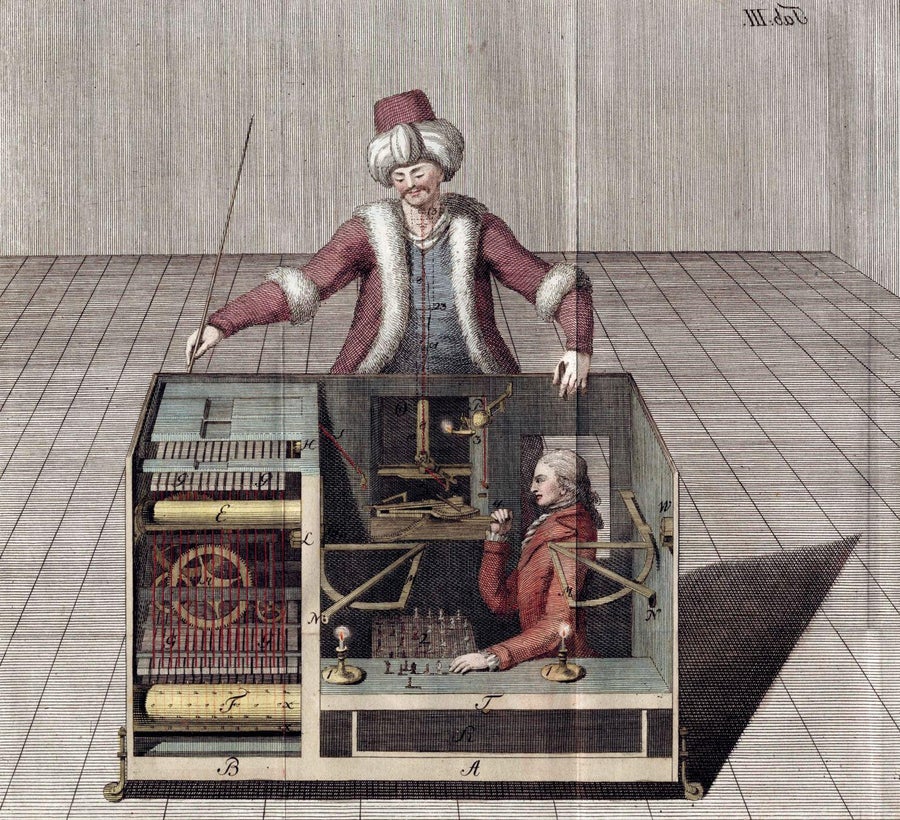Is There a Human Hiding behind That Robot or AI? A Brief History of Automatons That Were Actually People
A Temporary Historical past of Automatons That Had been Really Individuals
When human labor is hidden underneath the veneer of a robotic or AI instrument, that’s “fauxtomation”

If you happen to’ve ever requested a chatbot a query and obtained nonsensical gibberish in reply, you already know that “synthetic intelligence” isn’t all the time very clever.
And typically it isn’t all that synthetic both. That’s one of many classes from Amazon’s current determination to dial back its much-ballyhooed “Simply Stroll Out” procuring know-how, a seemingly science-fiction-esque software program that really functioned, in no small half, because of behind-the-scenes human labor.
This phenomenon is nicknamed “fauxtomation” as a result of it “hides the human work and likewise falsely inflates the worth of the ‘automated’ resolution,” says Irina Raicu, director of the Web Ethics program at Santa Clara College’s Markkula Heart for Utilized Ethics.
On supporting science journalism
If you happen to’re having fun with this text, think about supporting our award-winning journalism by subscribing. By buying a subscription you’re serving to to make sure the way forward for impactful tales in regards to the discoveries and concepts shaping our world right this moment.
Take Simply Stroll Out: It guarantees a seamless retail expertise through which clients at Amazon Recent groceries or third-party shops can seize objects from the shelf, get billed mechanically and go away with out ever needing to take a look at. However Amazon at one level had greater than 1,000 staff in India who educated the Simply Stroll Out AI mannequin—and manually reviewed a few of its gross sales—according to an article printed final yr on the Data, a know-how enterprise web site.
An nameless supply who’d labored on the Simply Stroll Out know-how instructed the outlet that as many as 700 human critiques had been wanted for each 1,000 buyer transactions. Amazon has disputed the Data’s characterization of its course of. An organization consultant instructed Scientific American that whereas Amazon “can’t disclose numbers,” Simply Stroll Out has “far fewer” staff annotating procuring information than has been reported. In an April 17 blog post, Dilip Kumar, vp of Amazon Net Companies functions, wrote that “that is no completely different than every other AI system that locations a excessive worth on accuracy, the place human reviewers are frequent.”
Information of this know-how’s retirement in U.S. Amazon Recent shops—in favor of procuring carts that allow clients scan objects as they store—has triggered renewed concentrate on an uncomfortable reality about Silicon Valley hype. Applied sciences heralded as automating away uninteresting or harmful work should want people within the loop, or as one Bloomberg columnist put it, AI software program “typically requires armies of human babysitters.”
It’s hardly a brand new phenomenon. All through historical past, canny inventors and entrepreneurs have sought to slap the “automated” label on what was actually simply regular human exercise. Take the “Mechanical Turk,” a robe-clad robotic that inventor Wolfgang von Kempelen debuted within the early 1770s. Von Kempelen would inform observers that the humanoid machine may play full video games of chess, opening up the automaton to indicate off clockwork mechanisms inside, as Atlas Obscura recounted.
However the Mechanical Turk was a sham. As many up to date observers started to suspect, a human operator was hiding in a chamber beneath the chessboard and controlling its actions by candlelight. The clockwork mechanisms had been merely window dressing for an simply impressed viewers.

Ueber den Schachspieler des Herrn von Kempelen und dessen Nachbildung by Joseph Racknitz, 1789.
Eraza Assortment/Alamy Inventory Picture
It’s maybe becoming that Amazon now runs a platform with the same name that lets corporations crowdsource piecemeal on-line duties that require human judgment, equivalent to labeling the coaching information that fashionable AI methods study from. In spite of everything, charades within the model of the unique Mechanical Turk—nominally automated methods that really depend on human assist, or what Jeff Bezos as soon as dubbed “synthetic synthetic intelligence”—are frequent options of the fashionable Net, the place an aura of technological sophistication can typically be extra essential than technological sophistication itself.
“The concept of bringing one thing inanimate to life is an previous and seemingly very human craving,” says David Gunkel, a professor of media research at Northern Illinois College and creator of The Machine Query: Important Views on AI, Robots and Ethics. Pointing to tales as diverse as Mary Shelley’s 1818 novel Frankenstein and the 2014 film Ex Machina, he provides, “It’s in these tales and eventualities that we play the position of God by creating new life out of inanimate matter. And it seems that the need to actualize this end result is so persistent and inescapable [that] we’re keen to cheat and deceive ourselves with the intention to make it a actuality.”
Even earlier than merchandise equivalent to ChatGPT and DALL-E kicked off the present synthetic intelligence growth, this dynamic performed out with much less formidable AI merchandise. Take into account X.ai, an organization that after touted an automatic private assistant that might schedule conferences and ship out e-mails. It turned out that the explanation X.ai’s software program appeared so lifelike was that it was actually alive, which Bloomberg reported in 2016: behind the scenes, human trainers had been reviewing virtually all inbound e-mails. Different concierge and private assistant packages from that period had been equally human-dependent, and Bloomberg’s report famous that the draw of enterprise capital might have incentivized start-ups to border peculiar workflows as cutting-edge.
It’s a dynamic that performs out throughout our more and more on-line life. That meals supply robotic carting a salad to your entrance door may truly be a younger online game fanatic piloting it from afar. You may assume a social media algorithm is sifting out pornography from cat memes, when in actuality human moderators in an workplace someplace are making the hardest calls.
“This isn’t only a query of promoting attraction,” Raicu says. “It’s additionally a mirrored image of the present push to carry issues to market earlier than they really work as supposed or marketed. Some corporations appear to view the ‘people contained in the machine’ as an interim step whereas the automation resolution improves.”
In current months the hype round generative AI has created thrilling new alternatives for folks to masks workaday human labor underneath a shiny, PR-friendly veneer of fauxtomation. Earlier this yr, for example, the Web erupted in a furor over a posthumous George Carlin stand-up particular that had purportedly simulated the late comedian’s humorousness with a machine-learning program educated on his oeuvre. However later, underneath the specter of a lawsuit from Carlin’s property, one of many video’s creators admitted by a spokesperson that the supposedly AI-generated jokes had actually been written by an peculiar particular person.
It was the newest in a centuries-old custom that continues to enchant and ensnare unwary shoppers: people pretending to be machines pretending to be people as soon as once more.





